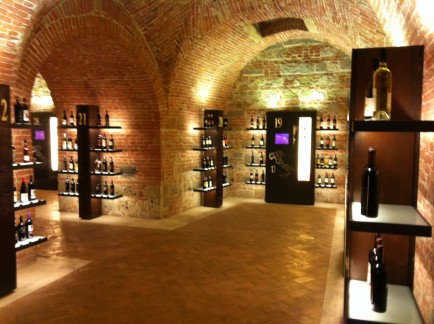Store Your Hamptons Wine Bottles In Custom Style

After a trip to Long Island wine country, you may have a few extra bottles to store. Whether you’re a small-time collector or a fine wine connoisseur, North Fork Wine Cellar Designs has you covered.
For the last eight years, Peter Cimino has been designing and installing custom wine cellars from Montauk to Manhattan. “For years, I worked out in the Hamptons putting in indoor swimming machines, and I was just looking for something else to get into,” he said. “I have a house up in Southold, and we belong to some of the wine clubs, so my niece suggested I get into wine cellars.”
Wine collecting is a booming hobby, and Cimino’s clients are keeping him busy. “It goes two ways: it’s either a status-symbol that they’re looking for, or they are true wine collectors that are purchasing and aging wine for a longterm period,” he said. “If you’re somebody that has a collection, or plan on collecting wine and aging it for the long-term, then you need the proper environment, and that’s where building a wine cellar in your residence comes in.”
Home wine cellars are essentially climate-controlled rooms with racks designed to hold wine bottles. “Wine cellar refrigeration can be very basic, with what we call a through-the-wall unit, which looks like an air conditioning system; or we can go super high-end with a computer-controlled humidity and heat system that you can hook up to a computer,” Cimino said. In addition to refrigeration, North Fork Wine Cellar Designs also offers custom racking styles that range from classic wood or stone to more contemporary metal. “You can go any way you want, depending on how much you want to spend,” he explained.
When it comes to designing the cellar, Cimino advises his clients to think big in the beginning. “I try to tell the clients that once you build a wine cellar, you tend to start collecting more wine. Some wines can be aged for 15, 20, or 25 years, so don’t think of what you have now—think of what you’ll end up with five years from now,” he said. “I haven’t had any, but there have been cases where customers have built wine cellars and then had to build a second one because they ran out of space.”
Collecting wine can be a pricy endeavor, and a home wine cellar is certainly a luxury, but despite the down economy, Cimino hasn’t noticed any decline in business. “It seems like it has picked up, actually, over the last couple of years,” he noted.
During that time, Cimino has had a chance to design and build some intricate and expansive wine cellars. “I did a 1,500 bottle custom distressed-lacquer white oak one in Bridgehampton last year, with the computer-controlled refrigeration system,” he said. “And I’m doing one now, in Watermill, that’s somewhere between eight and nine thousand bottles.” Cimino’s smallest cellar held 500 bottles. “It really depends on how in-depth the client is in to collecting wine.”
While it is definitely easier to create and install a wine cellar in a home that’s still in the design phase, Cimino has no problem working within the constraints of an existing structure. “If it’s a new house, then it could be almost unlimited, but not everybody has the space to put in a huge wine cellar,” Cimino said. “I put one in a 19-inch deep, 15-foot long, 10-foot high closet in downtown Tribeca last year, so it really depends on the spaces that are available to the client.”
Along with private residences, Cimino also works with some restaurants as well. “I am working with a couple of restaurants right now in Nassau County,” he said. “But some of the higher-end restaurants have their own custom steelwork, and I don’t really have the capacity to do that.”
Cimino’s wine cellars are all custom and are only limited by the client’s desires. “The only thing that determines what a person wants to do with a wine cellar, is the collection they have now or the collection they plan to have in the future,” he said.









